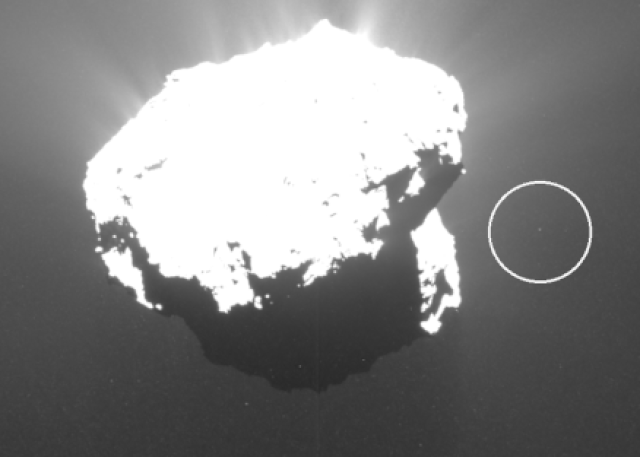Europe's Rosetta spacecraft wasn't the only object circling Comet 67P/Churyumov-Gerasimenko back in 2015.
Earlier this year, Spanish astrophotographer Jacint Roger was going through photos captured by Rosetta, which studied Comet 67P up close from August 2014 through September 2016. He noticed a small chunk of orbiting debris in images taken on Oct. 21, 2015, when Rosetta was about 250 miles (400 kilometers) from the comet.
Roger posted an animated GIF on Twitter this past May that showed the motion of this newly identified body, which Rosetta team members have dubbed "Churymoon."
Related: Photos: Europe's Rosetta Comet Mission in Pictures

Churymoon, which was was once part of Comet 67P, appears to be about 13 feet (4 meters) wide, European Space Agency (ESA) officials said.
"Modelling of the Rosetta images indicates that this object spent the first 12 hours after its ejection in an orbital path around 67P/C-G at a distance of between 2.4 and 3.9 km [1.5 to 2.4 miles] from the comet’s center," ESA officials wrote in a statement today (Aug. 12).
"Afterwards, the chunk crossed a portion of the coma, which appears very bright in the images, making it difficult to follow its path precisely," they added. "However, later observations on the opposite side of the coma confirm a detection consistent with the orbit of the chunk, providing an indication of its motion around the comet until 23 October 2015."
Get the Space.com Newsletter
Breaking space news, the latest updates on rocket launches, skywatching events and more!
Comets eject large quantities of debris when they get close to the sun. Our star's heat cooks cometary nuclei, causing water ice to sublimate into vapor, which carries dust and other material away as it escapes into space. The fuzzy coma surrounding a cometary nucleus is a cloud of such debris, after all.
Still, Churymoon is pretty special. It's "likely the largest chunk detected around the comet and will be subject to further investigations," ESA officials wrote in the same statement.
¿Maybe little coorbital chunk? @ESA_Rosetta 🧐☄️COMET #67P/CHURYUMOV-GERASIMENKO 1 (1969 R1)☄️INTERNATIONAL #ROSETTA MISSIONSTART_TIME : 2015-10-21TARGET_CENTER_DISTANCE : 408 kmOSIRIS - NARROW ANGLE CAMERAESA/Rosetta/MPS/OSIRIS/UPD/LAM/IAA/SSO/INTA/UPM/DASP/IDA/j. Roger pic.twitter.com/GDY3nE0iymMay 8, 2019
The Rosetta mission launched in March 2004. A dozen years later, it became the first spacecraft ever to orbit a comet. There was another big first to follow as well: In November 2014, the Rosetta mothership dropped a washing-machine-size lander called Philae onto the surface of the 2.5-mile-wide (4 km) Comet 67P.
While NASA's Deep Impact probe intentionally slammed into Comet Tempel 1 in 2005, no spacecraft had ever pulled off a cometary soft landing until Philae did so. (And Philae barely succeeded; the lander's anchoring harpoons failed to fire as planned, and the probe bounced several times before settling on the comet for good.)
The groundbreaking Rosetta mission's fieldwork came to an end on Sept. 30, 2016, when team members brought the orbiter down intentionally on Comet 67P. The icy wanderer is now streaking toward the outer solar system with two defunct machines on its complex, craggy surface.
- Surprise! Scientists Recover Rosetta Spacecraft's Last Photo of Comet 67P
- Best Close Encounters of the Comet Kind
- The Truth Behind This Amazing Video from the Surface of a Comet
Mike Wall's book about the search for alien life, "Out There" (Grand Central Publishing, 2018; illustrated by Karl Tate), is out now. Follow him on Twitter @michaeldwall. Follow us on Twitter @Spacedotcom or Facebook.
Join our Space Forums to keep talking space on the latest missions, night sky and more! And if you have a news tip, correction or comment, let us know at: community@space.com.

Michael Wall is a Senior Space Writer with Space.com and joined the team in 2010. He primarily covers exoplanets, spaceflight and military space, but has been known to dabble in the space art beat. His book about the search for alien life, "Out There," was published on Nov. 13, 2018. Before becoming a science writer, Michael worked as a herpetologist and wildlife biologist. He has a Ph.D. in evolutionary biology from the University of Sydney, Australia, a bachelor's degree from the University of Arizona, and a graduate certificate in science writing from the University of California, Santa Cruz. To find out what his latest project is, you can follow Michael on Twitter.









